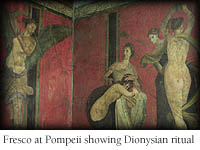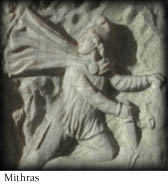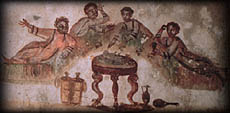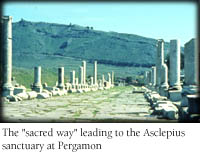The Empire's Religions
The Empire offered a banquet of religious options: the gods of Olympus, mystery cults, and dieties from foreign lands.William Goodwin Aurelio Professor of the Appreciation of Scripture, Boston University
PAGANISM IN THE ANCIENT WORLD
 Paganism is our designation for what ninety-something percent of the people in the Mediterranean were doing. Jews are a visible minority, and then, everybody is doing lots of other things. Paganism is extremely various. It's local. It's energetic. It has all sorts of different layers. The gods appear to people routinely. People are in contact with their gods. There's an interesting story in the Acts of the Apostles, where Paul and, I can't remember if it's Silas or Barnabus, work a cure in a town and the people who are witnessing him do this decide that it's Zeus and Hermes who have come to town. And the Priests start lugging out an animal to sacrifice and Paul says, "No, no, no, no, you don't ... let me tell you this." And then he starts. But that's an interesting measure of how common the expectation is that gods appear. Gods appear in dreams. People fall asleep every night. So there's a contact between heaven and Earth that's articulated in terms of traditional Roman and Greek culture.
Paganism is our designation for what ninety-something percent of the people in the Mediterranean were doing. Jews are a visible minority, and then, everybody is doing lots of other things. Paganism is extremely various. It's local. It's energetic. It has all sorts of different layers. The gods appear to people routinely. People are in contact with their gods. There's an interesting story in the Acts of the Apostles, where Paul and, I can't remember if it's Silas or Barnabus, work a cure in a town and the people who are witnessing him do this decide that it's Zeus and Hermes who have come to town. And the Priests start lugging out an animal to sacrifice and Paul says, "No, no, no, no, you don't ... let me tell you this." And then he starts. But that's an interesting measure of how common the expectation is that gods appear. Gods appear in dreams. People fall asleep every night. So there's a contact between heaven and Earth that's articulated in terms of traditional Roman and Greek culture.
If you were a pagan person living in the first century, you would have, first of all, the gods of your own family, who[m] you would be responsible to. Some kind of ancestor worship, or perhaps if you were an aristocratic Roman, Venus or one of the other gods might be, as with Julius Caesar's family, might be one of the founding ancestors of your particular household. You would have the gods of the city, itself. And it's those city gods, in combination with the gods of the Empire, that would structure time for you. Because it's the city gods and the civic holidays that give you your days off. Five day holidays that are the feast of this or the feast of that. Literally, when everybody stops working and rich patrons of the city would pay for banquets.
There's all sorts of religions. It's incredibly rich. It's not unlike twentieth century America. You have low-tech religions, like magic. People routinely go to magicians. If you have a sinus infection. If you need somebody to fall in love with you. If you're betting on a horse and you've lost the past three races, you go to a professional. We have magic books that are books of recipes, and they're indexed and you can look up what you need, and the professional will help you. By the way, Jews and also Christians, enter into this magical inheritance, too....
It's a spiritual universe that's thickly populated with gods and spirits. When you look up into the stars at night, you see thousands of heroes and ... and maybe where your soul will go if you know how to slip the coil and go back through the planetary spheres, and go up. Paganism is the rich native religious stew of traditional society in the Mediterranean. And centuries after even the conversion of Constantine, we find endowments to liturgies, to mystery cults, to different Egyptian and Greco-Roman gods. Paganism continues on even after the conversion to Christianity.
President of the Faculty, Union Theological SeminaryA RELIGIOUS SUPERMARKET
 [In the Roman Empire] you have an enormous set of religious options. It would be like going to a supermarket and being able to sort of shop for God. And you have them at various times in your life and for various functions of your living. If you were ill and had access to a physician and could afford the care of a physician, certainly you would do that, but if the physician didn't work out or if you didn't have access to a physician then you would have gone to a sanctuary of Aesclepius.
[In the Roman Empire] you have an enormous set of religious options. It would be like going to a supermarket and being able to sort of shop for God. And you have them at various times in your life and for various functions of your living. If you were ill and had access to a physician and could afford the care of a physician, certainly you would do that, but if the physician didn't work out or if you didn't have access to a physician then you would have gone to a sanctuary of Aesclepius.
Your principal deity, however, might well be Athena, the Athena of the city. And so you would take part in the civic celebrations around Athena, who would be the protector of the city. If one were a farmer, or even if were not, but dependent on agriculture, certainly Dionysus would have been a very important deity, the one who makes things grow. Dionysus was a beloved character in the Roman Empire; we find him everywhere.
 There were any number of very popular deities. In the rural areas Pan was a very popular deity, and we're finding more and more grottos of Pan where there would have been devotions directed to Pan in the grove, shrines for various nymphs and forest phenomena. Certainly Artemis was a very popular deity. In fact, one version of Artemis is Artemis Lochia who oversees childbirth, and we find dedications of women who have just had children or who are going to have children invoking the care of Artemis Lohea as they go through childbirth. One would have found a rich array of deities meeting the various needs of individuals in this particular period.
There were any number of very popular deities. In the rural areas Pan was a very popular deity, and we're finding more and more grottos of Pan where there would have been devotions directed to Pan in the grove, shrines for various nymphs and forest phenomena. Certainly Artemis was a very popular deity. In fact, one version of Artemis is Artemis Lochia who oversees childbirth, and we find dedications of women who have just had children or who are going to have children invoking the care of Artemis Lohea as they go through childbirth. One would have found a rich array of deities meeting the various needs of individuals in this particular period.
CULT OF THE EGYPTIAN GODS
n the religious mix of the time, it's very important to realize that one would have experienced institutions and deities who would come from rather remote places. In the Hellenistic period, in the 3rd, 2nd centuries BCE, a number of very important religions that had been distinctive to Egypt and to Syria, for example, began to migrate in substantial ways, in very important ways, throughout the Roman Empire. One would have found in the major cities of the Mediterranean basin a cult of the Egyptian gods. One would have cults of the Syrian gods.... The Egyptian cult and Mithraism were two of the great religious movements of the time and certainly would have posed some of the most difficult competition for Christianity.
 Egyptian cults come in a whole host of varieties, but let's sort of take the garden variety. The garden variety of the Egyptian cult would have included probably Isis as the ascendant deity. Isis was perceived by her devotees as being remarkably attentive. Isis would respond to you when you were in trouble. She would answer your prayers. She had that reputation. A bit more removed is Isis's consort, Serapis, again, a creature from the Hellenistic period. Serapis is a bit less popular, again at the popular level, with the people. One very often finds him as a consort of Isis. Serapis is viewed as a more remote, Jupiter-like, Zeus-like, figure and is often in fact presented in iconography with the characteristics of Jupiter and Zeus.
Egyptian cults come in a whole host of varieties, but let's sort of take the garden variety. The garden variety of the Egyptian cult would have included probably Isis as the ascendant deity. Isis was perceived by her devotees as being remarkably attentive. Isis would respond to you when you were in trouble. She would answer your prayers. She had that reputation. A bit more removed is Isis's consort, Serapis, again, a creature from the Hellenistic period. Serapis is a bit less popular, again at the popular level, with the people. One very often finds him as a consort of Isis. Serapis is viewed as a more remote, Jupiter-like, Zeus-like, figure and is often in fact presented in iconography with the characteristics of Jupiter and Zeus.
Then one would have also encountered in the Egyptian cult Harpocrates, and this was specifically a Holly creation. Hippocrates was understood as a youth associated with Isis.... Hypocrates was characterized in the iconography very interestingly, with his finger to his lips invoking the silence of the mysteries of the Egyptian cult. Mysteries were a very important part in Egyptian religion and made it terribly attractive to people because one could be introduced into a special knowledge and a special way of viewing things and probably a special promise of afterlife....
ISIS ICONOGRAPHY
Isis was presented in a number of different ways. Sometimes in her more austere Egyptian presentation, in which she's quite heraldic, in which she's quite static, but then also one finds her in more Hellenized presentations that remind one, for example, of Demeter or Artemis. She went through a very important Hellenization. And then one of the most important representations of Isis is what we call the Isis lactans, that is Isis suckling, nurturing her offspring at her breast. This is a kind of iconography that appears to have been terribly determinative in the early iconography of Mary and Jesus.
Professor of Classics and Director of the Religious Studies Program University of Texas at AustinLINK BETWEEN RELIGIOUS AND CIVIC LIFE IN THE ROMAN EMPIRE
Religion in the Roman empire or what we tend to call paganism was really very much a public affair. It was a blend of belief in the old deities of the Greek and Roman pantheons. The kind of stories that are told in Greek mythology. Put together with civic pride, honor and duty. The very term liturgy comes from a Greek word that designates the duties, the obligations of the civic magistrates in observing the festival days of the city. One went and performed one's liturgies if you were the mayor of the city and that has both a public civil function and also a pious religious function. .... To be a citizen of the polis, the very word from which we get politics. To be a citizen of the city is to be a part of the economy of human life that extends from the earth into the heavens, thus in their view of the world there's an integral relationship between the gods worshipped in the temples down the street and the work of the civil magistrates in carrying out law and justice and civil welfare.
MITHRAISM
 One of the most important competitors on the religious front with which Christianity would have to deal was the cult of the Persian God, Mithras. Now this too, like, Christianity, was a rather late arriving religion in the Roman empire. We don't really hear much about the Mithras cult before the second century about the same time that Pliny starts to recognize Christians. But by the end of the second century there are Mithraic chapels. .... Mithraic chapels spread throughout most of the major cities, especially in the Western part of the empire. Now this Mithras is actually a deity that we hear of in very old Hindu and ... Zoroastrian religious texts. So the name has been around for many, many centuries, but by the second century of the Common Era in the Roman world the Mithras cult becomes a new expression of a kind of Eastern religiosity and Eastern spirituality that was finding a great deal of popularity among Greeks and especially among Romans.
One of the most important competitors on the religious front with which Christianity would have to deal was the cult of the Persian God, Mithras. Now this too, like, Christianity, was a rather late arriving religion in the Roman empire. We don't really hear much about the Mithras cult before the second century about the same time that Pliny starts to recognize Christians. But by the end of the second century there are Mithraic chapels. .... Mithraic chapels spread throughout most of the major cities, especially in the Western part of the empire. Now this Mithras is actually a deity that we hear of in very old Hindu and ... Zoroastrian religious texts. So the name has been around for many, many centuries, but by the second century of the Common Era in the Roman world the Mithras cult becomes a new expression of a kind of Eastern religiosity and Eastern spirituality that was finding a great deal of popularity among Greeks and especially among Romans.
It is sometimes suggested that Mithraism was especially popular among the military but even then we know it's also popular among civil magistrates in certain cities. It's not just traveling with the legions. Now Mithraism is an interesting case precisely because Mithras is a kind of sun god. He's associated with the unconquerable or invincible sun, and indeed, if you think about it, Jesus too is often attached to a kind of solar deity identity. After all, he's worshipped on the day of the sun, Sunday. Jesus rises from the dead, much like the sun rising in the East, so this solar imagery that we hear of in relation to Mithraism is something that we find very comparable to certain aspects of early Christianity.
Also, Mithraism seems to practice rituals of initiation. You have to be born into the cult in some way by going through a ritual that makes you a member. They seem to have communal meals in their private little chapels and so from the perspective of a pagan walking down the street of some of these cities, it probably would have been difficult, unless they really knew what was going on in some of these buildings, difficult to distinguish this little house over here where the Mithraists meet and that little house over there where the Christians meet. They're secretive. They're small. They do these unusual things and people whisper about them, worried about what they do.
CULTIC DINING
 The Christians do fit into the larger panorama of the religious and social life of the Roman world in some interesting ways. Now we have to remember that one of the most important features of Christian practice is communal dining, the Lord's supper. In Paul's day we have to remember that Christians actually gather for worship around the dinner table and partake of a communal meal in commemoration of the death and resurrection of Jesus. But that communal meal was also an important ritual aspect that bonded the members of the community together. Dining itself, though, was nothing uncommon as a religious performance among members of the Roman world. Dinner parties were given all time. Private dinner parties as well as public festivals, but one of the most interesting aspects of dining that we find is what we might call religious or cultic dining, or club banquets; in these club banquets more often than not there's a kind of patron deity who could be expected to oversee the proceedings.
The Christians do fit into the larger panorama of the religious and social life of the Roman world in some interesting ways. Now we have to remember that one of the most important features of Christian practice is communal dining, the Lord's supper. In Paul's day we have to remember that Christians actually gather for worship around the dinner table and partake of a communal meal in commemoration of the death and resurrection of Jesus. But that communal meal was also an important ritual aspect that bonded the members of the community together. Dining itself, though, was nothing uncommon as a religious performance among members of the Roman world. Dinner parties were given all time. Private dinner parties as well as public festivals, but one of the most interesting aspects of dining that we find is what we might call religious or cultic dining, or club banquets; in these club banquets more often than not there's a kind of patron deity who could be expected to oversee the proceedings.
The Mithras cult is known for its dining practices but one of the most popular form of cultic dining that we hear about is found in the Egyptian cults. The cult of Serapis, the god from Egypt, the consort of Isis. We have papyrus invitations from the Roman world which say the god Serapis invites you to dinner at his couch. Meaning his dinner table, his dinner party at eight o'clock on Tuesday evening ... So it's interesting that the Christians do something that looks very much like these religious practices, and at times they actually have to work very hard to distinguish themselves from what the pagans do.
The Christian writer Tertullian from North Africa around the year 197 really goes way out on a limb to try to make some distinctions. He says, "We Christians hold meals, sure, but we really don't do anything all that extraordinary. In fact, they're very tame. It's not at all like those people who follow the god Serapis. Why when they throw a dinner party you have to call out the fire brigades. We're nothing like that." But indeed the very point that he has to make suggests that in the eyes of a lot of people that's exactly how they looked.
ASCLEPIUS, THE HEALING GOD
When Christians talked about salvation we have to understand how a pagan would have heard that term. Salvation actually is a term of healing. It's medical, and it apparently was understood to mean deliverance from disease and death. Healing, magic, medical cures are part of the Jesus tradition going way back to ... the early gospel sources, and it continues to be a very important part of Christian tradition. One of the most prominent scenes in all the catacombs is of Jesus as healer. Jesus as magician. This is really something very important within the Roman culture, and apparently health and disease were very important issues all around. It's often suggested that the mortality rate among members of Roman cities might have been as high as fifty percent of all children born died within the first five years of life. So death and disease were all around....
 One of the most popular deities of all is Asclepius, the healing God, and it's often suggested that Jesus is kind of modeled after a new or a younger Asclepius. Asclepius is often portrayed in some ways similar to Zeus as this great, old bearded god and he also has his wife or consort. Her name is Hygeia. Her name means health in Greek, and so the worship of Asclepius the healer and of health personified as his wife are very prominent cults. Indeed, the equivalent of hospitals for ancient society was really the temple of Asclepius, and we see these in a number of places around the Greek and Roman world. ...[T]he Asclepius cult, very much like Christianity and some of the other new religions of the Greco-Roman world, was a portable cult. You could have temples of Asclepius almost anywhere. Anywhere you're willing to have one built and pay for it.
One of the most popular deities of all is Asclepius, the healing God, and it's often suggested that Jesus is kind of modeled after a new or a younger Asclepius. Asclepius is often portrayed in some ways similar to Zeus as this great, old bearded god and he also has his wife or consort. Her name is Hygeia. Her name means health in Greek, and so the worship of Asclepius the healer and of health personified as his wife are very prominent cults. Indeed, the equivalent of hospitals for ancient society was really the temple of Asclepius, and we see these in a number of places around the Greek and Roman world. ...[T]he Asclepius cult, very much like Christianity and some of the other new religions of the Greco-Roman world, was a portable cult. You could have temples of Asclepius almost anywhere. Anywhere you're willing to have one built and pay for it.
[W]hat happened in a temple of Asclepius was that one went there to take the cures. It was kind of like a spa. You could go and sleep in the temple. They call that incubating in the temple, and bathe in their ritual baths and offer incense and prayers and buy sacrifices from the cult priests. In order to try to get the god to perform a healing, and it's interesting that we have a mixture of real medicine. That is, real scientific medical practice going on side-by-side with these religious magical kinds of healing practices. So the ancients really thought of the two things going very much hand in hand and everyone knew about Asclepius. He was one of the most important gods around. After all, who else could give you health?
Read more about religions in the Roman Empire in this essay by Marianne Bonz.
